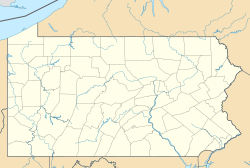Wagner Free Institute of Science facts for kids
|
Wagner Free Institute of Science
|
|
 |
|
| Location | 1700 West Montgomery Avenue Philadelphia, Pennsylvania |
|---|---|
| Built | 1859-1865 |
| Architect | John McArthur Jr.; Collins & Autenrieth |
| Architectural style | Classical Revival, Renaissance |
| Website | www.wagnerfreeinstitute.org |
| NRHP reference No. | 89000361 |
Quick facts for kids Significant dates |
|
| Added to NRHP | May 17, 1989 |
| Designated NHL | December 14, 1990 |
The Wagner Free Institute of Science is a cool natural history museum located in Philadelphia, Pennsylvania. It was started way back in 1855. This special place is like a time capsule, showing us what a science center looked like in the Victorian era. It has a museum, a research area, a library, and places for learning. The buildings, built between 1859 and 1901, still show off the amazing collections of its founder, William Wagner. Because of its unique buildings and how well they've been kept, it's even called a National Historic Landmark.
Contents
How the Institute Began
The Wagner Free Institute was founded in 1855 by William Wagner. He was a merchant, a generous person, and a gentleman scientist. This means he loved science and studied it, even though it wasn't his main job. William Wagner wanted everyone to be able to learn about the natural world for free.
He started by giving free science talks at his home, Elm Grove, in 1847. To make his talks interesting, he used a collection of specimens he had gathered since he was a boy. Anyone could attend these classes, including both women and men. The talks became so popular that he had to move them to a bigger public hall in 1855.
Later, the Institute moved to its permanent home. This building was designed by a famous Philadelphia architect, John McArthur Jr.. He also designed Philadelphia's City Hall.
Growing and Changing Over Time
William Wagner continued to give lectures and lead the Institute until he passed away in 1885. After that, the Board of Trustees chose Joseph Leidy to lead the science and education programs. Leidy was a very famous biologist.
Leidy's time at the Institute was very busy and productive. He greatly expanded the Institute's goals and programs. His most important contribution was reorganizing the museum. He added many more specimens to Wagner's original collection. He found these new items through field trips, purchases, and other ways.
Leidy personally arranged the museum's displays. He organized the specimens and cases based on evolution theory. This meant visitors would see simpler organisms first, then move to more complex ones. They would also travel through different periods of Earth's history as they walked through the hall. This new display opened in 1891. It has changed very little since Leidy's time. This makes the Institute a rare example of a Victorian era science museum.
In 1892, the first branch of the Philadelphia Public Library opened at the Wagner Institute. This library later became the Free Library of Philadelphia. The library branch stayed open until 1962.
The Institute Today
The Wagner Free Institute still works to achieve William Wagner's original goals. It continues to offer free science courses. It also functions as a library, a lecture hall, and a museum. The museum has more than 100,000 specimens! These include minerals and fossils that William Wagner himself collected.
Today, the Wagner Free Institute of Science is known as one of Philadelphia's historical treasures. It works to protect its historic building and collections for future generations. The Institute also provides great educational programs. These programs cover science, natural history, and the history of science from the 1800s to now. The Institute has received support from the National Endowment for the Humanities to help preserve its building and collections.
Images for kids
Related Places to Explore







